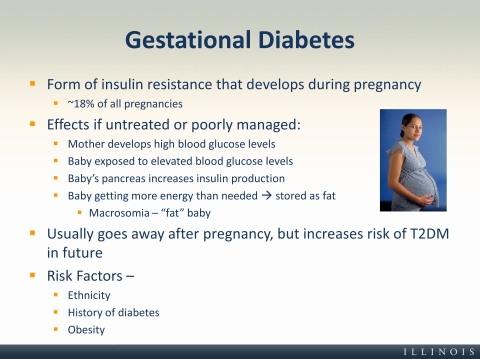
KIN 122 - Diabetes
Table of Contents
- Disease-related Terms and Diabetes
- Objectives
- Disease-related terms (1)
- Disease-related terms (2)
- Disease-related terms (3)
- Diabetes Mellitus Statistics
- Trends in diabetes mellitus prevalence in adults =20 years of age by sex (National Health and Nutrition Examination Survey: 1988-1994 and 2005-2008)
- Childhood Diabetes
- Trends in Obesity and Diabetes
- Diabetes Mellitus
- Type 1 Diabetes Mellitus
- Type 2 Diabetes Mellitus (1)
- How diabetes affects your blood sugar
- Type 2 Diabetes Mellitus (2)
- Risk Factors for Type 2 Diabetes Mellitus
- Gestational Diabetes
- Symptoms of Diabetes
- Diabetes complications
- Preventing diabetes complications
- Physical Activity and Type 2 Diabetes
- Physical Activity and Type 2 Diabetes: Mechanisms
- Living with diabetes
- Sources
Text and Images from Slide
Gestational Diabetes
- Form of insulin resistance that develops during pregnancy
- ~18% of all pregnancies
- Effects if untreated or poorly managed:
- Mother develops high blood glucose levels
- Baby exposed to elevated blood glucose levels
- Baby's pancreas increases insulin production
- Baby getting more energy than needed ? stored as fat
- Macrosomia - "fat" baby
- Usually goes away after pregnancy, but increases risk of T2DM in future
- Risk Factors -
- Ethnicity
- History of diabetes
- Obesity

